LOTUS S-TYPE GUITAR
8/13/24, updated 8/15/24
My niece recently gave me a guitar that belonged to her husband, who unexpectedly passed away about a year ago. She wanted me to have his first guitar, a Lotus S-type (Stratocaster-type). When I was learning to play and still really struggling, he was joyously helpful and encouraging every time we talked. This was especially meaningful to me because he had been a touring musician. He knew his craft, so advice and encouragement from him was invaluable. I’ve been trying to learn about his instrument, and this is what I’ve discovered.
The guitar
Here’s the guitar. It has the classic Stratocaster shape in black with a 25.5" scale length. There are no serial numbers or identifying stickers on the outside or inside of the guitar. Given his age and assuming he took up guitar when he was a teenager, it would suggest the guitar was made in the late 1980s to early 1990s, if it was purchased new.
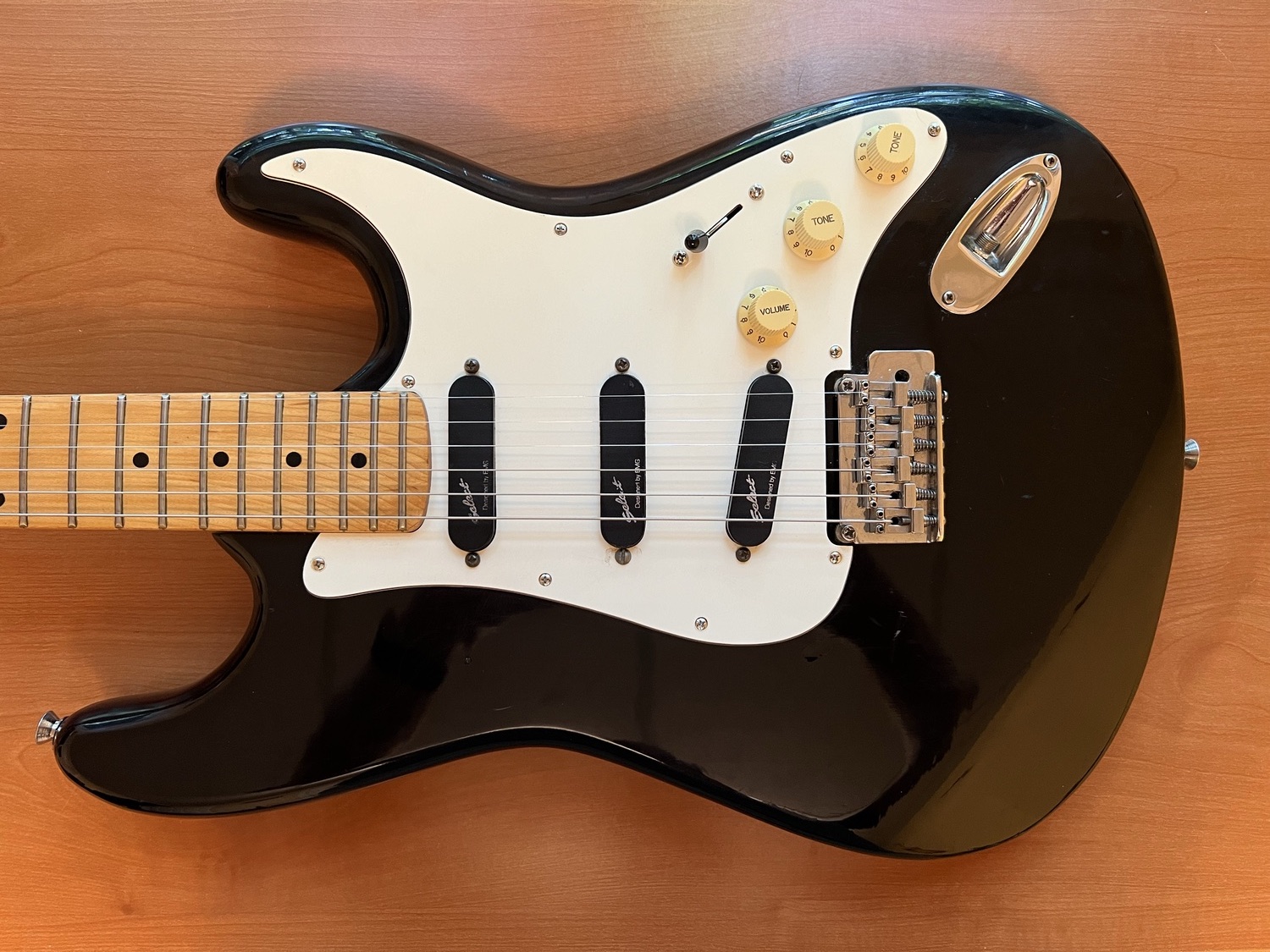
The white pickguard has three layers, with a black middle layer. It is attached with ten screws, as opposed to the usual eleven on a Fender Strat.
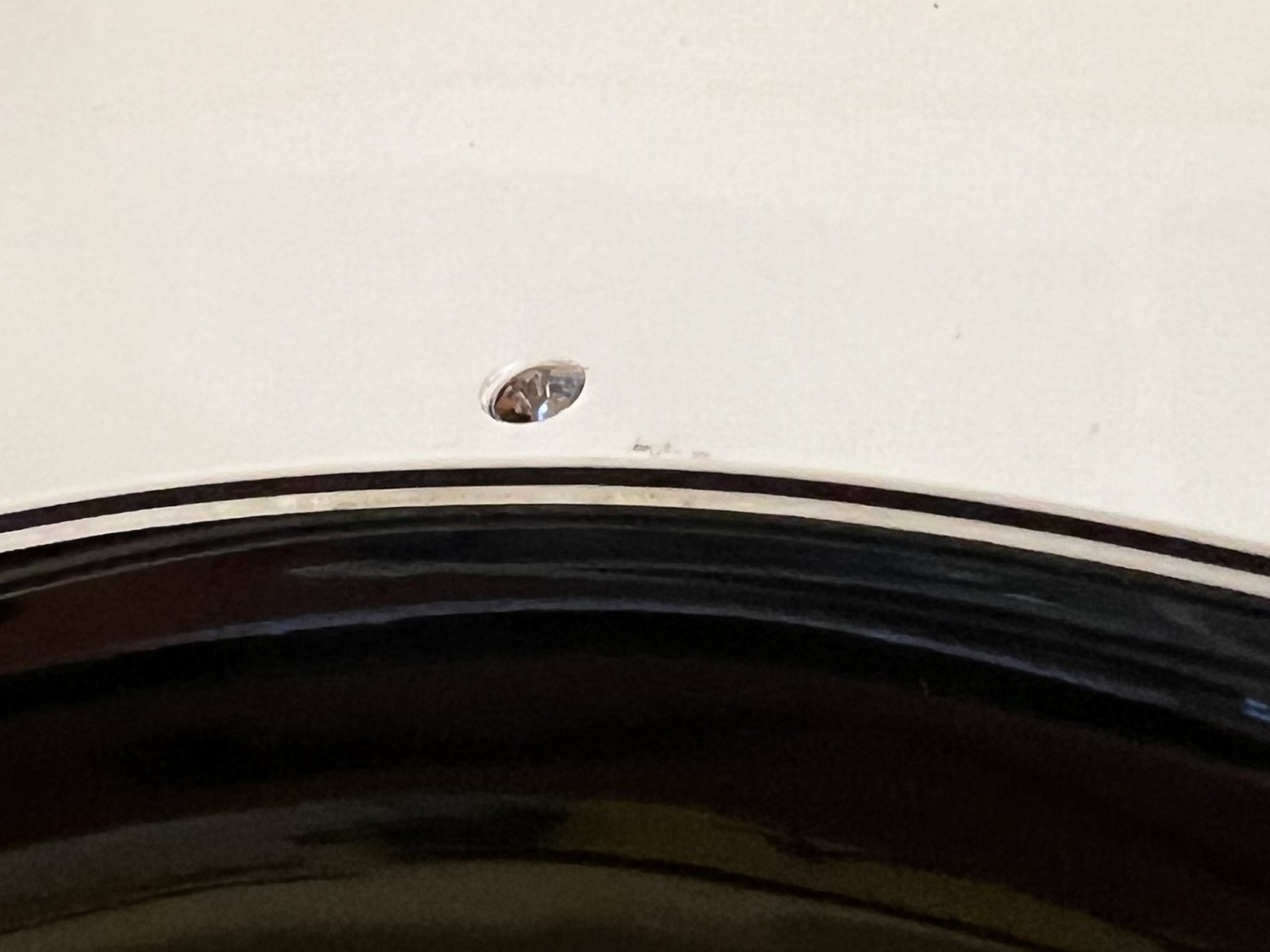
The headstock has an unusual inline shape, similar to a Jackson style, although the low E string on mine meets the nut at a strong angle instead of being straight, as is more typical on a Jackson headstock. The truss rod cover is triangular. Black screws originally held this on, but one screw was missing. I was unable to purchase a black #2 screw, so I replaced all three with brass screws.
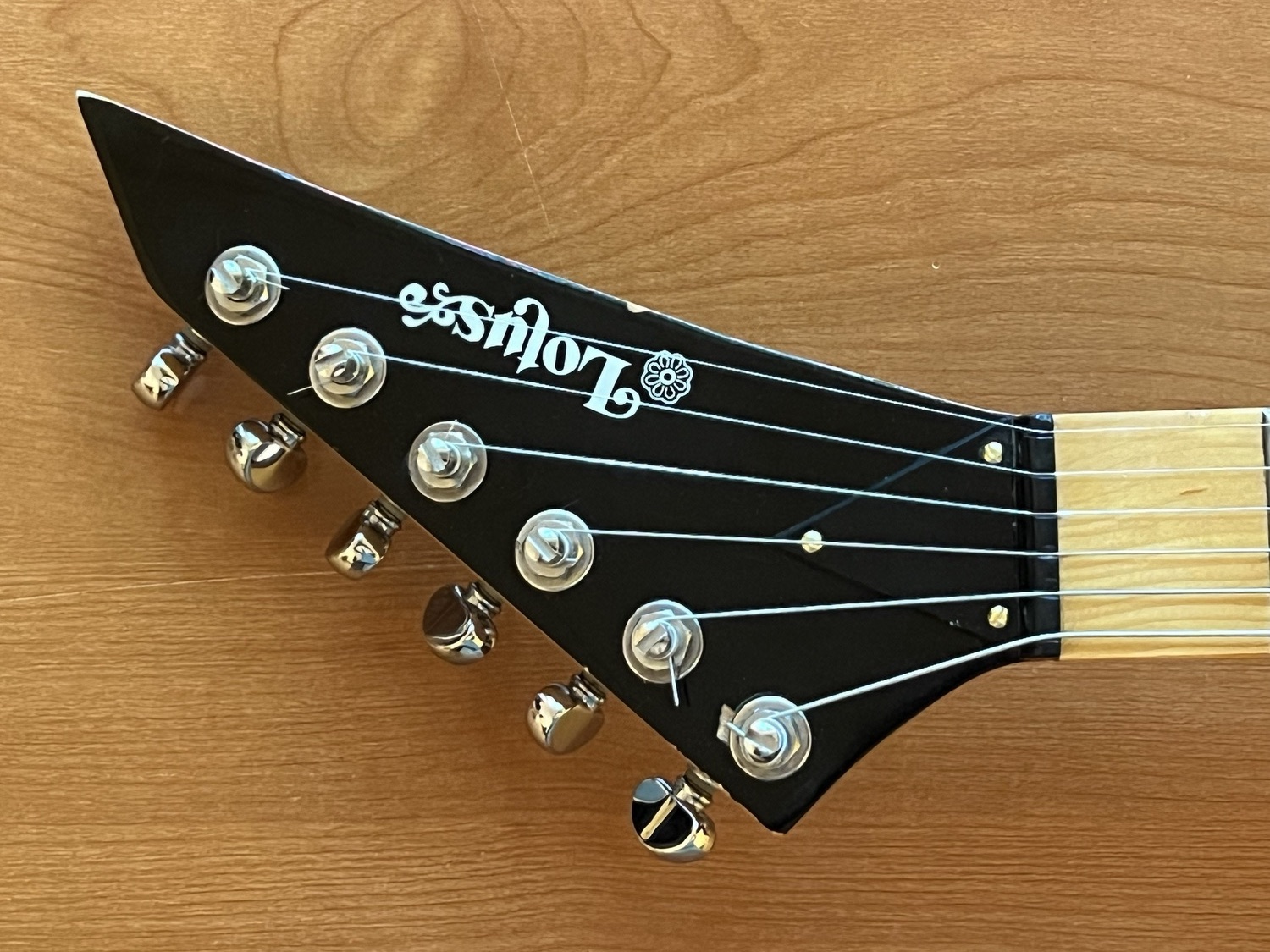
The side of the headstock has three circular wood plugs. They are only on the side opposite the tuners. I don’t know what these are for; none of my other guitars have them. The headstock and neck are cut from a single piece of wood, not joined with a scarf joint.
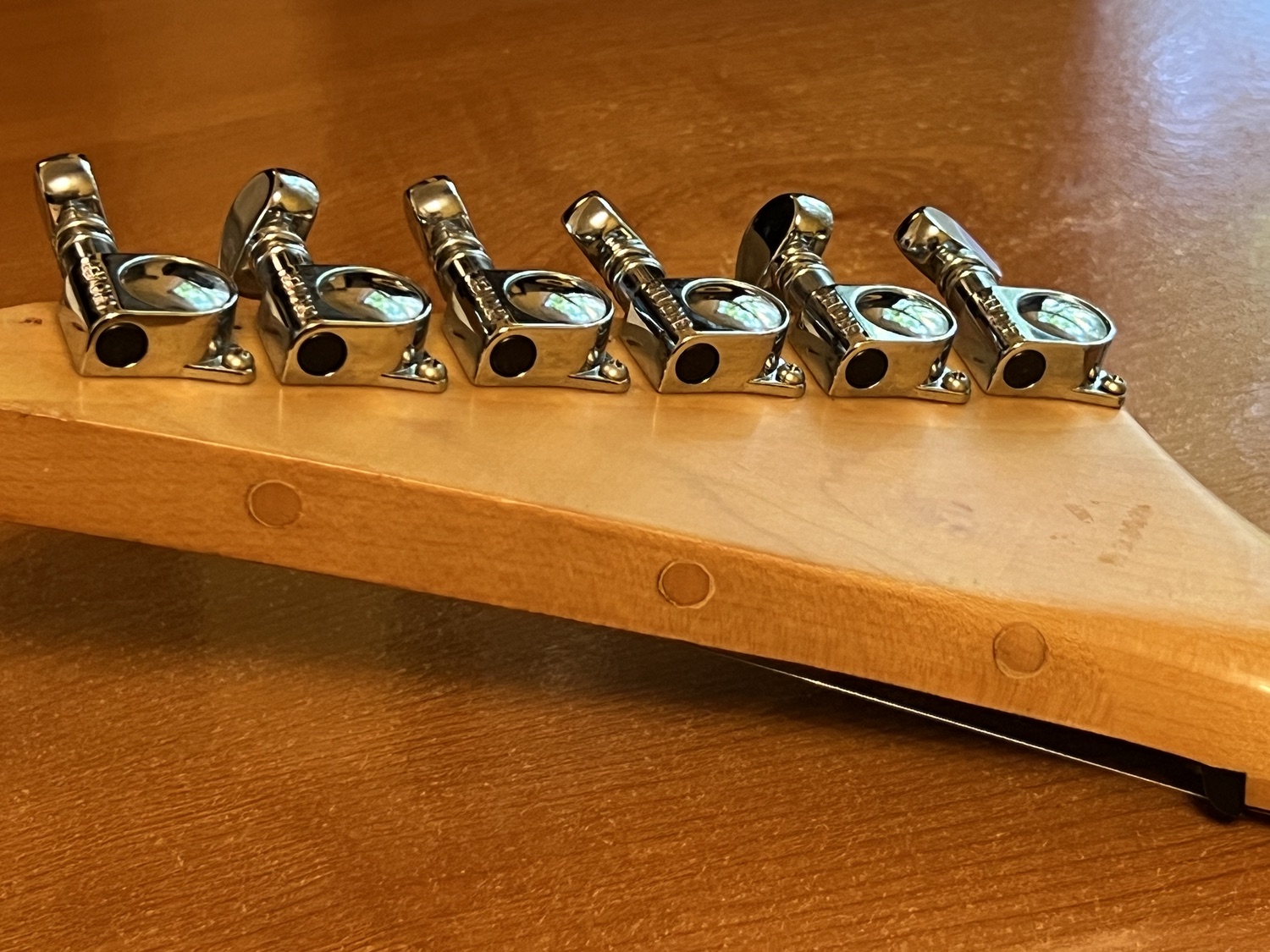
The tuners are Grovers, but I suspect these are mods as there is an open drill hole to the left of each tuner.
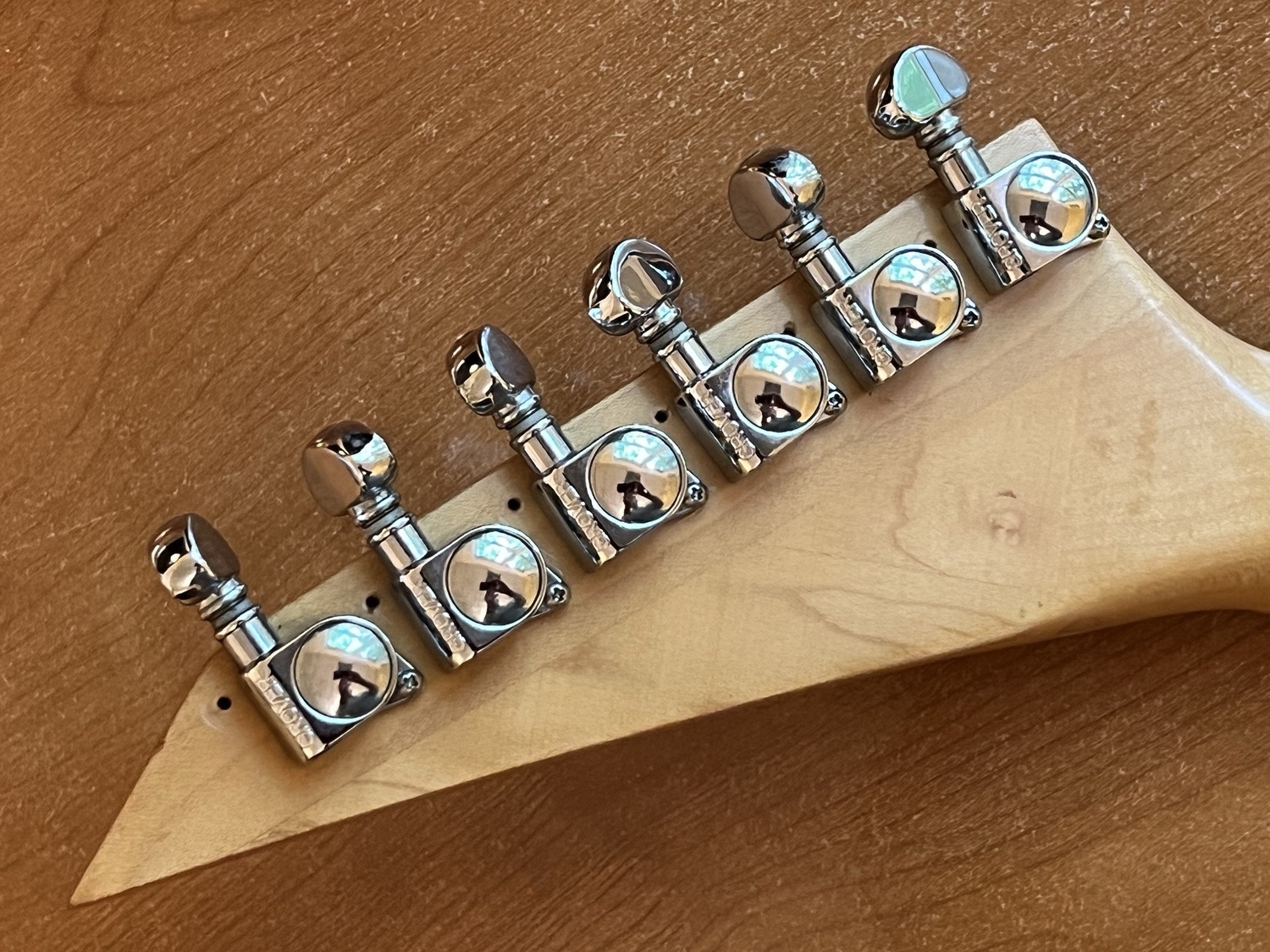
The neck and fingerboard look like maple. The fret markers are simple black circular inlays.
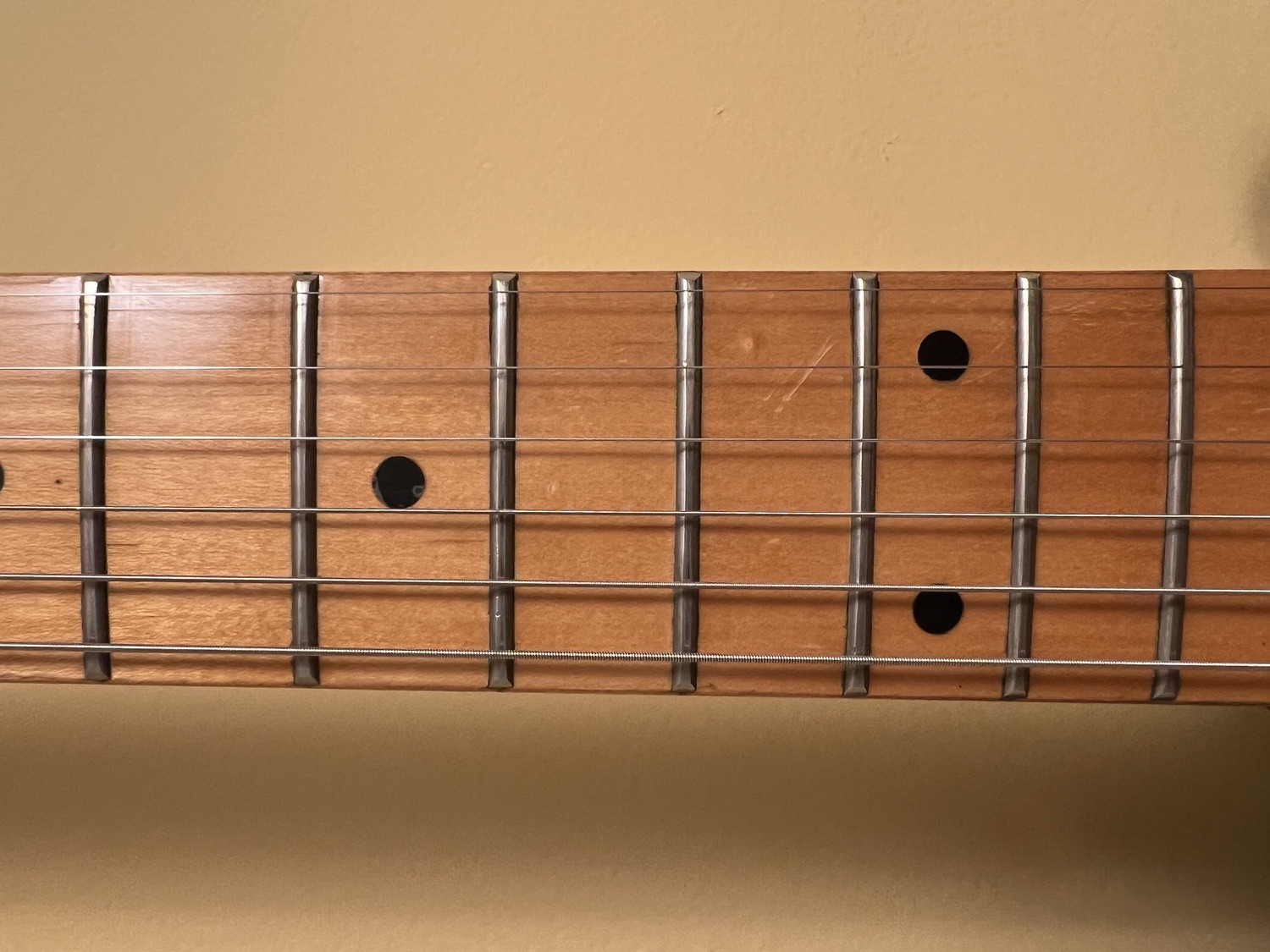
The back of the neck is simple with no center stripe (“skunk” stripe).

The upper side of the neck has simple black circular fret markers.
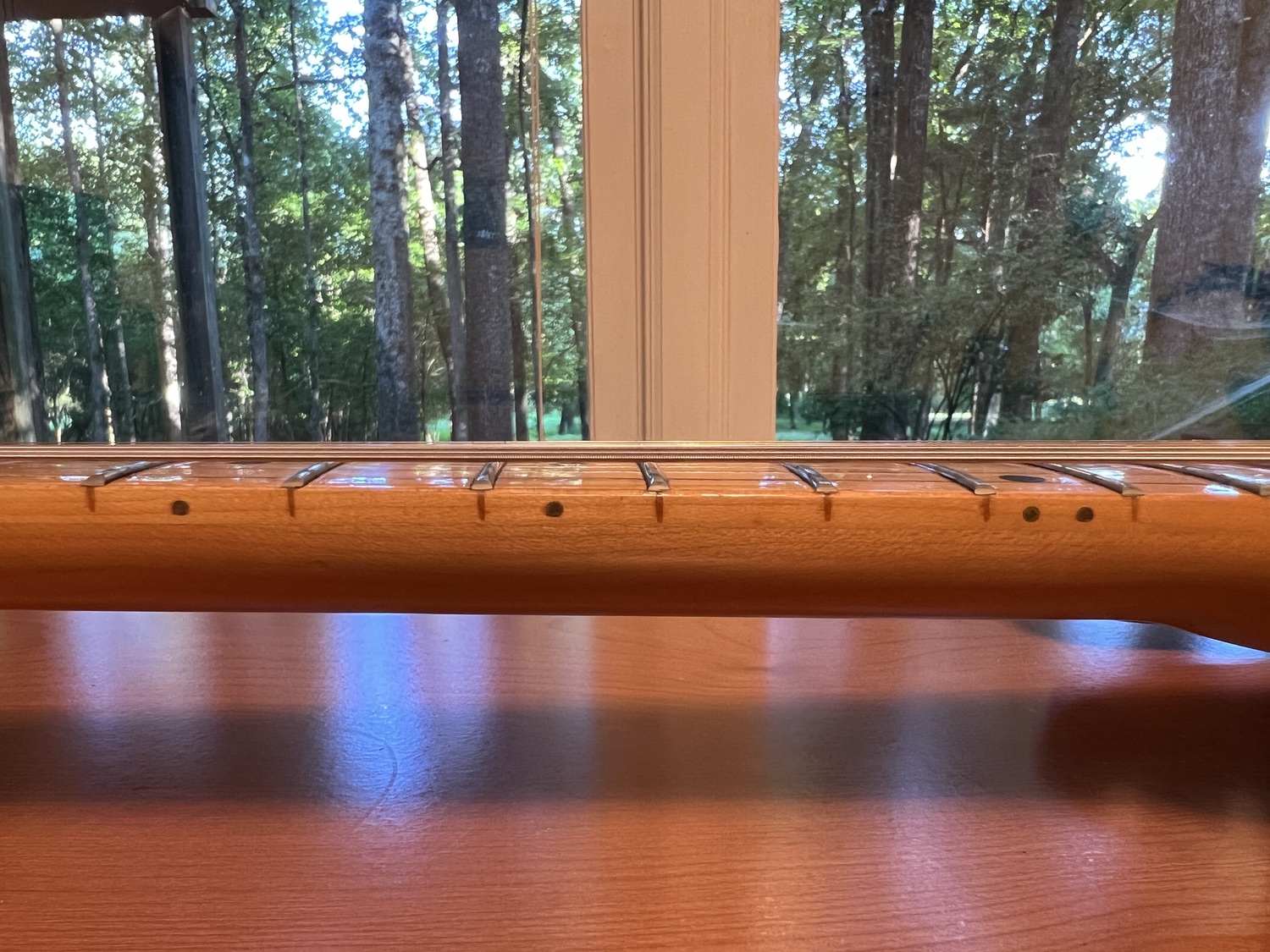
The neck is bolted on. The screw plate is unbranded, and four Phillips screws secure it. It also has a single Allen (hex) screw in the center on the body side of the plate. I have not seen a hex screw like this on other neck plates and eventually discovered that it allows the angle of the neck to be adjusted. A friend also said he’d never seen an adjustment screw like this before.
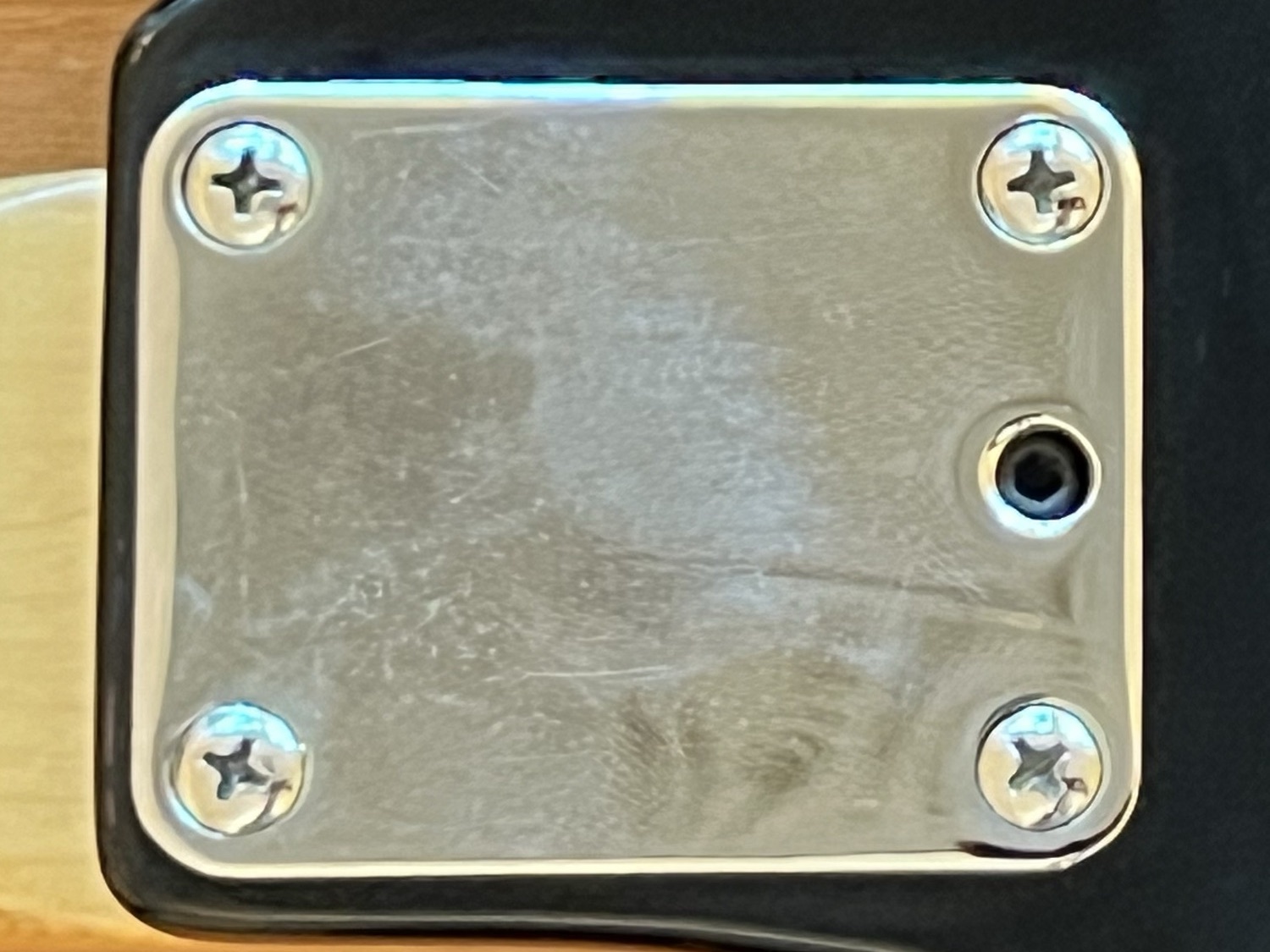
The bridge is a two-point tremolo system with steel bent saddles, and the tremolo arm must have been lost. The bridge has been locked down, deactivating the tremolo system, possibly to rectify tuning stability, especially when changing tunings.
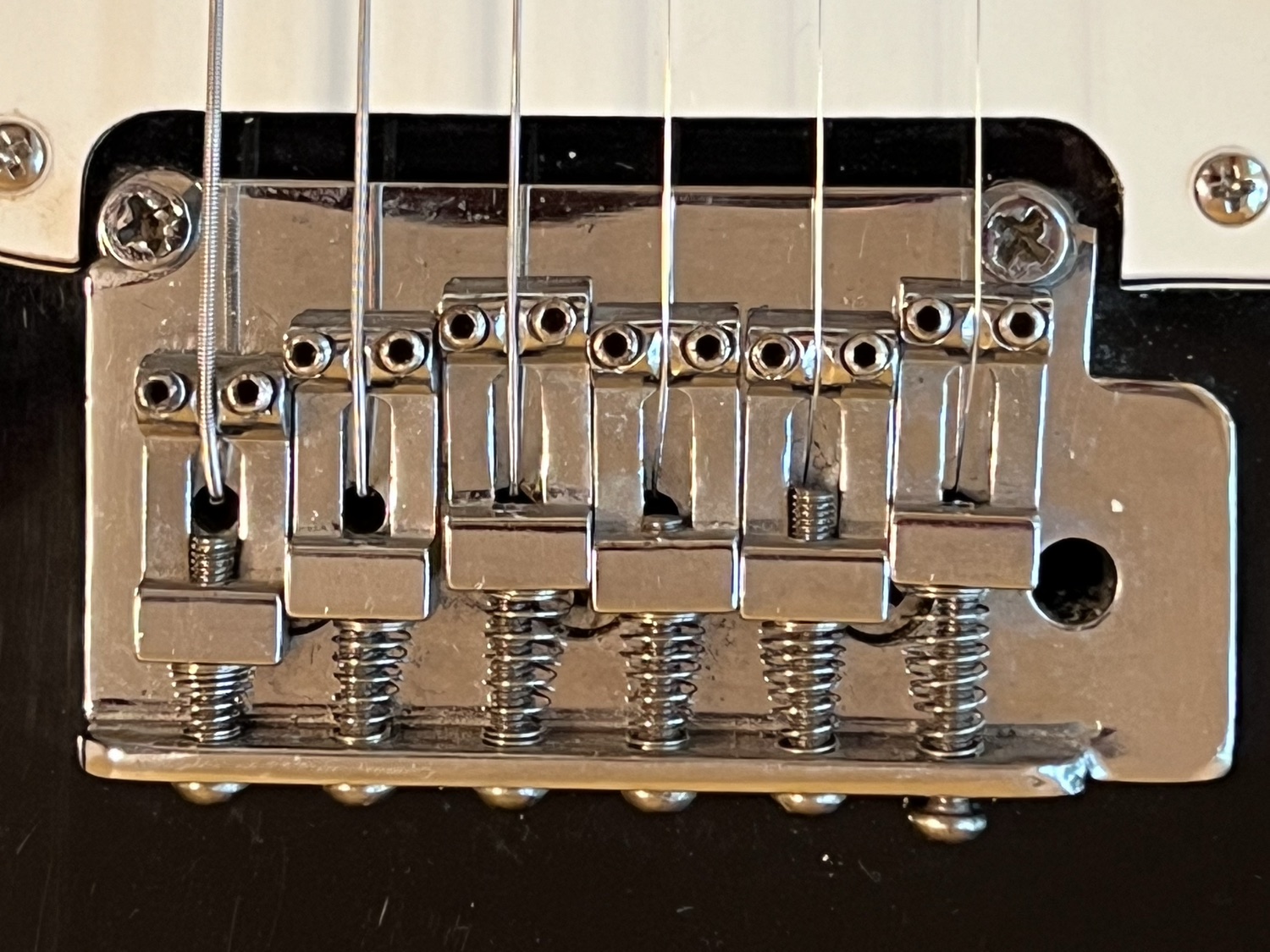
The tremolo is supported by three tension springs, but there are attachment points for five springs. The cutout for the tremolo springs is L-shaped.
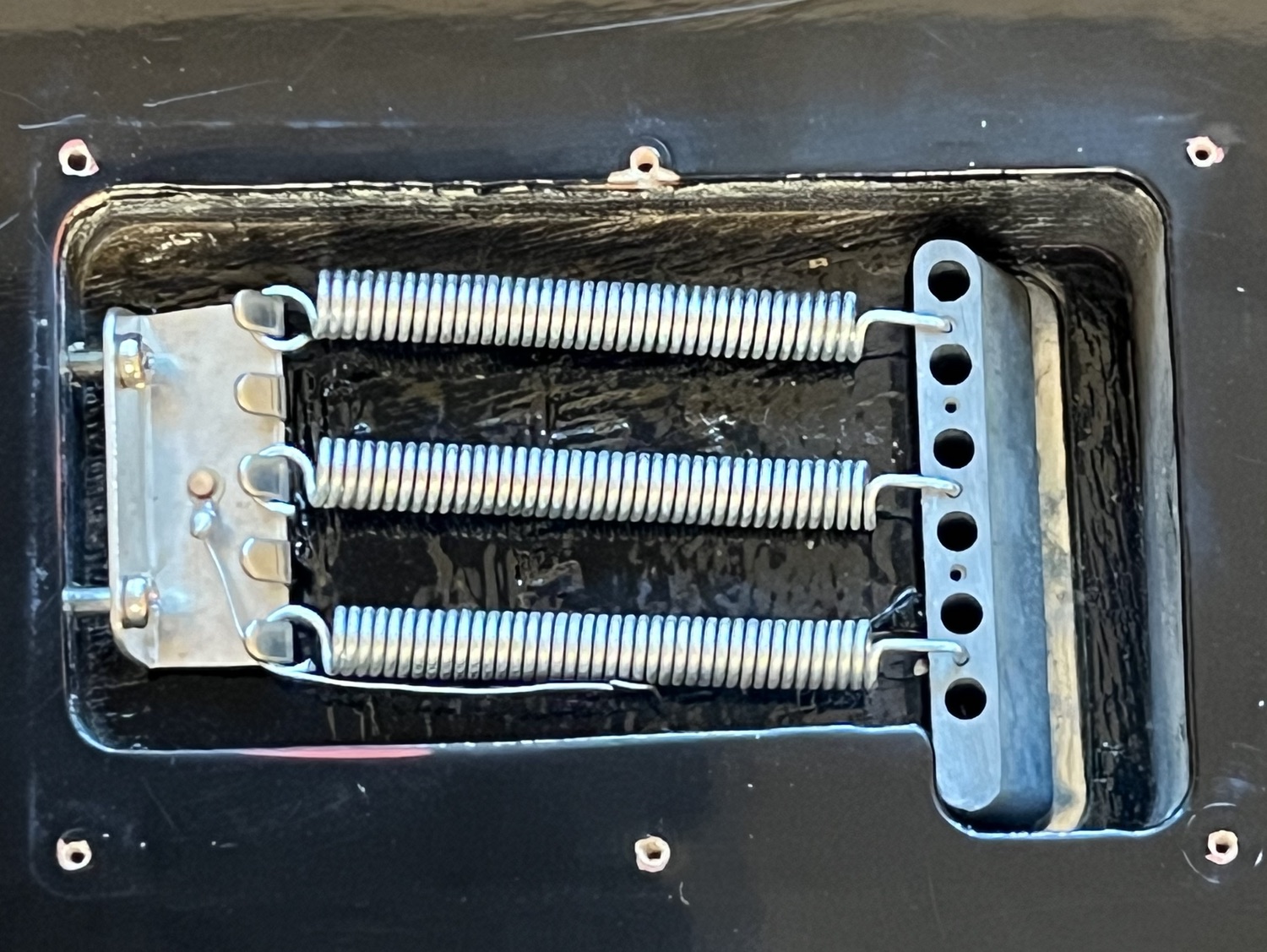
The tremolo cover is ivory and held by six screws. I’ve since replaced these with new Dimarzio screws.
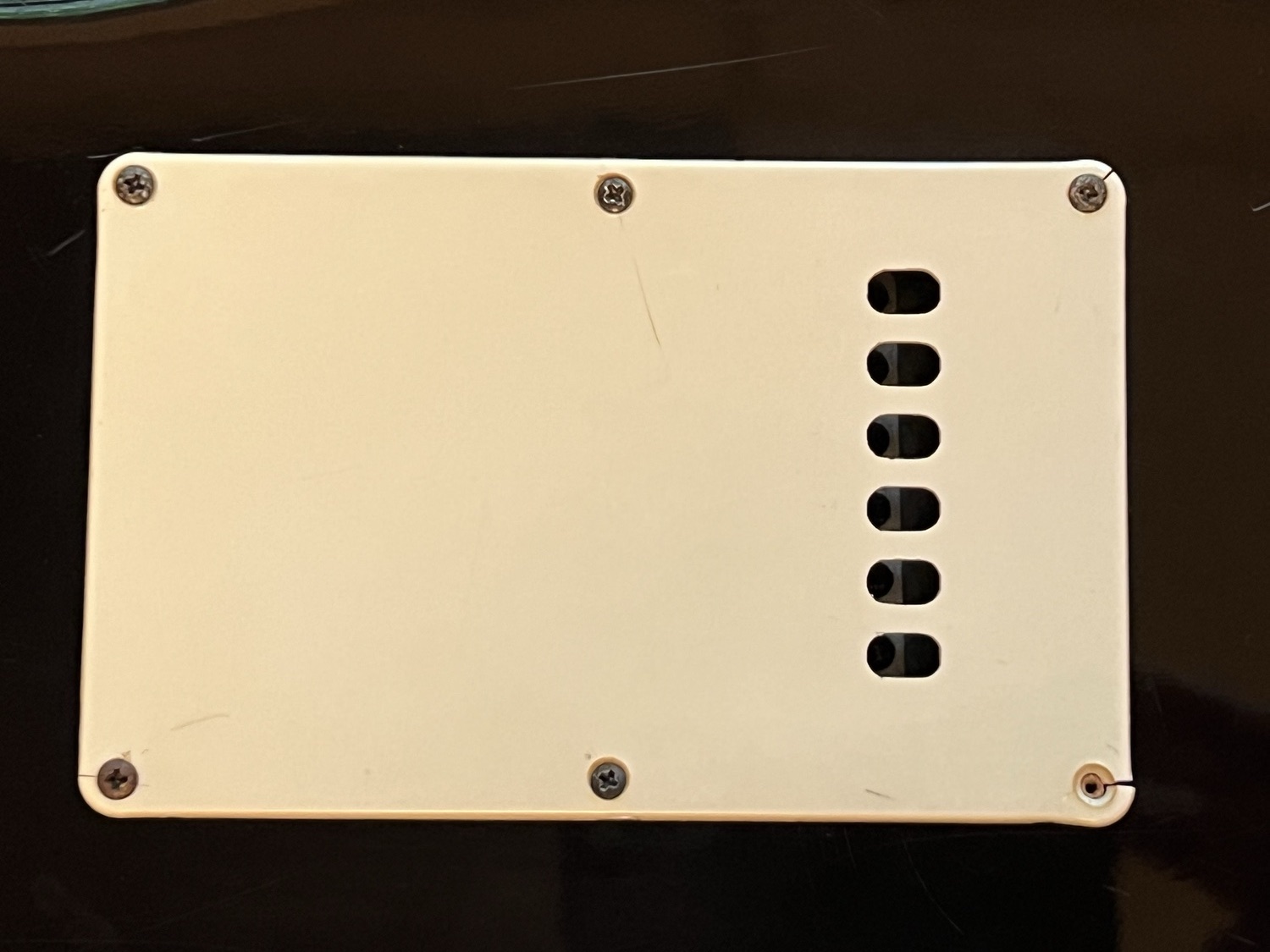
The wood grain is apparent inside the cutouts for the tremolo springs and the electronics: the body is laminate (plywood), a common material for entry-level guitars.
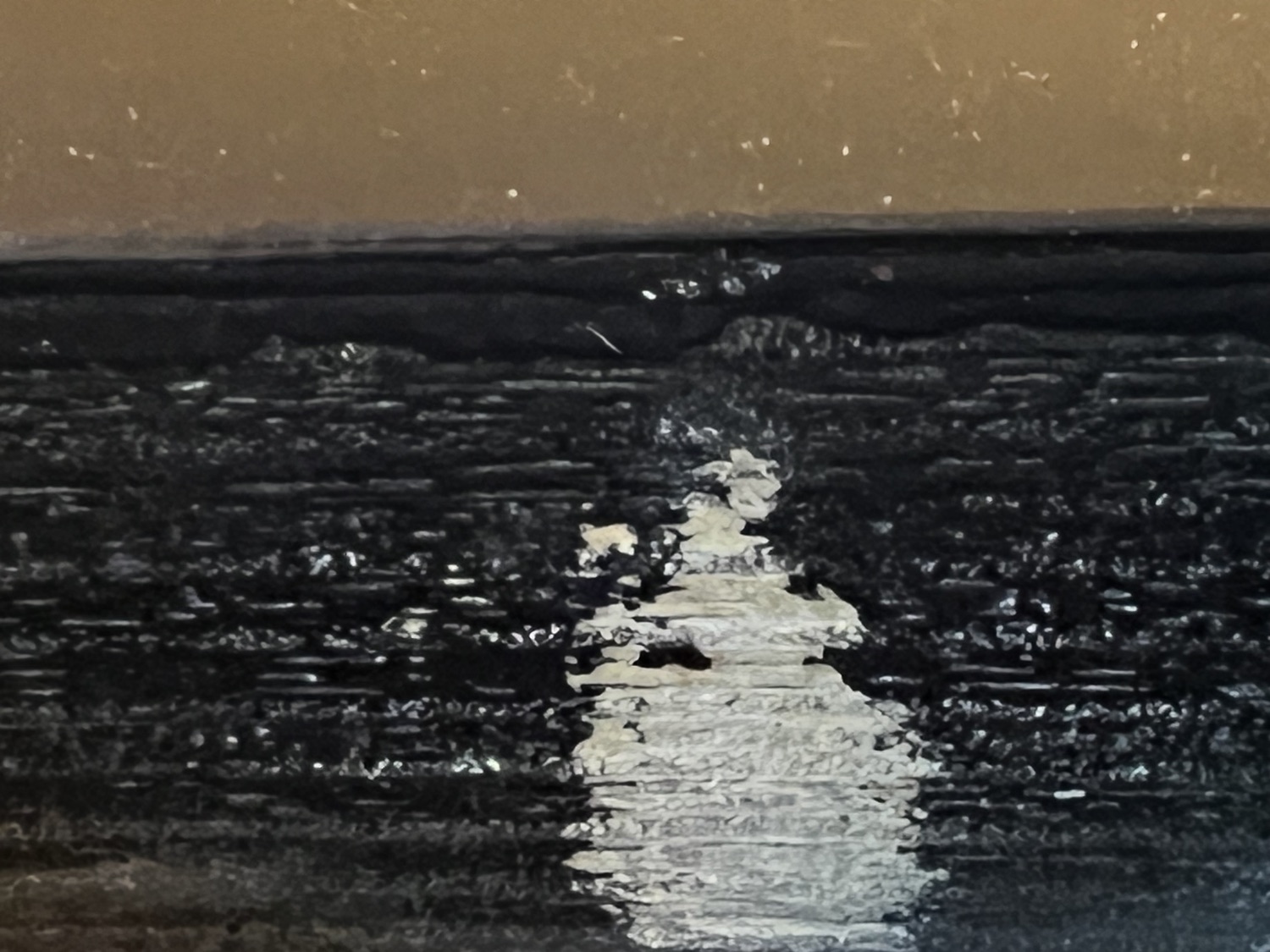
The pickups are EMG Select SES passive single-coil pickups. My niece told me that these were one of his mods, not original equipment. These were apparently sold in the 1980s. Although they look like single-coil pickups and several sites describe them as such, one listing on reverb claims that they are “actually noiseless stacked humbuckers. They are lower output (B-6.24k / M-5.9k / N-6.15k)”. Another discussion board says something similar: “Sonically, they are not at all like classic Strat single coils. They sound more like P90/PAF crosses without much output.”
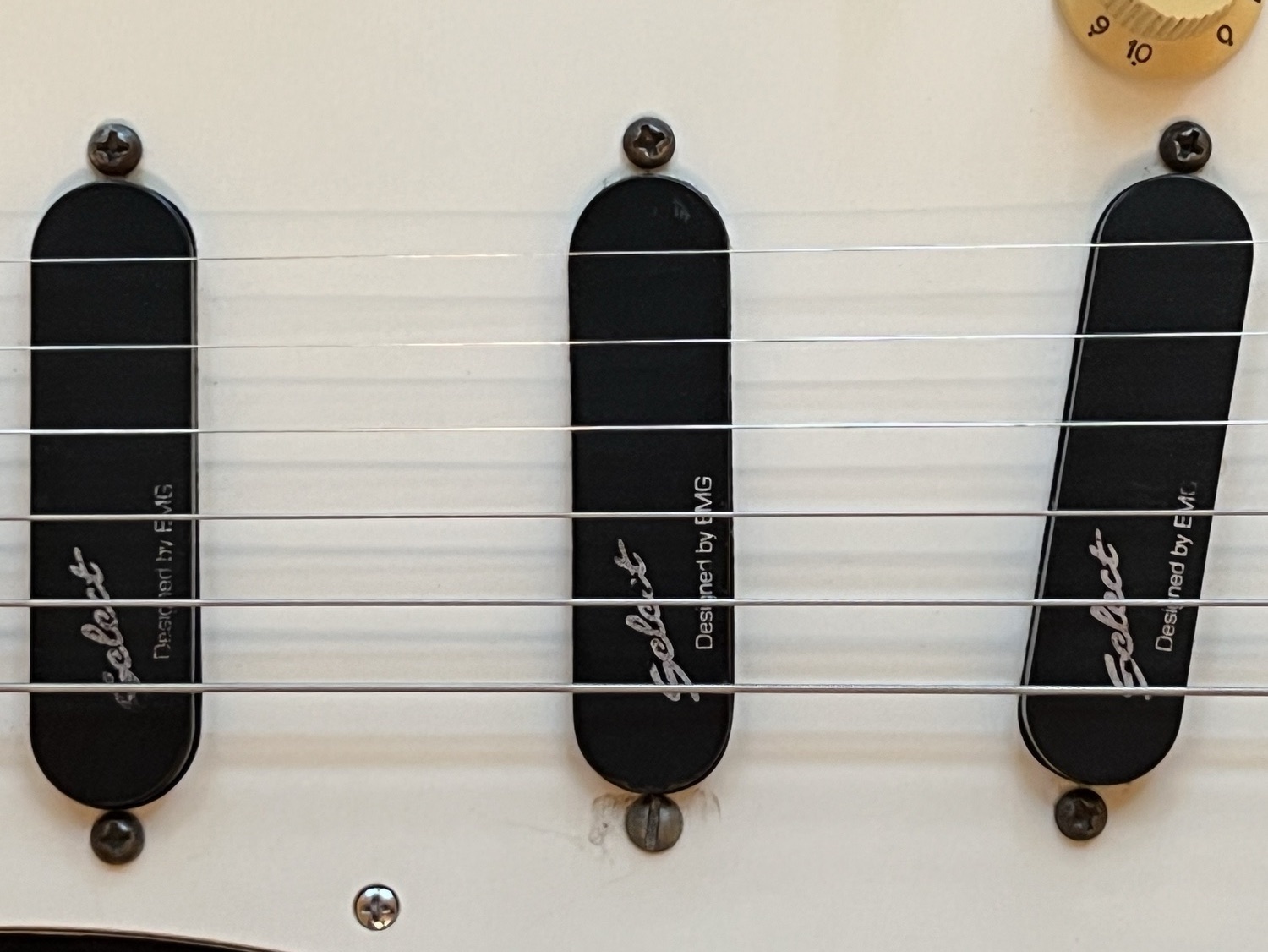
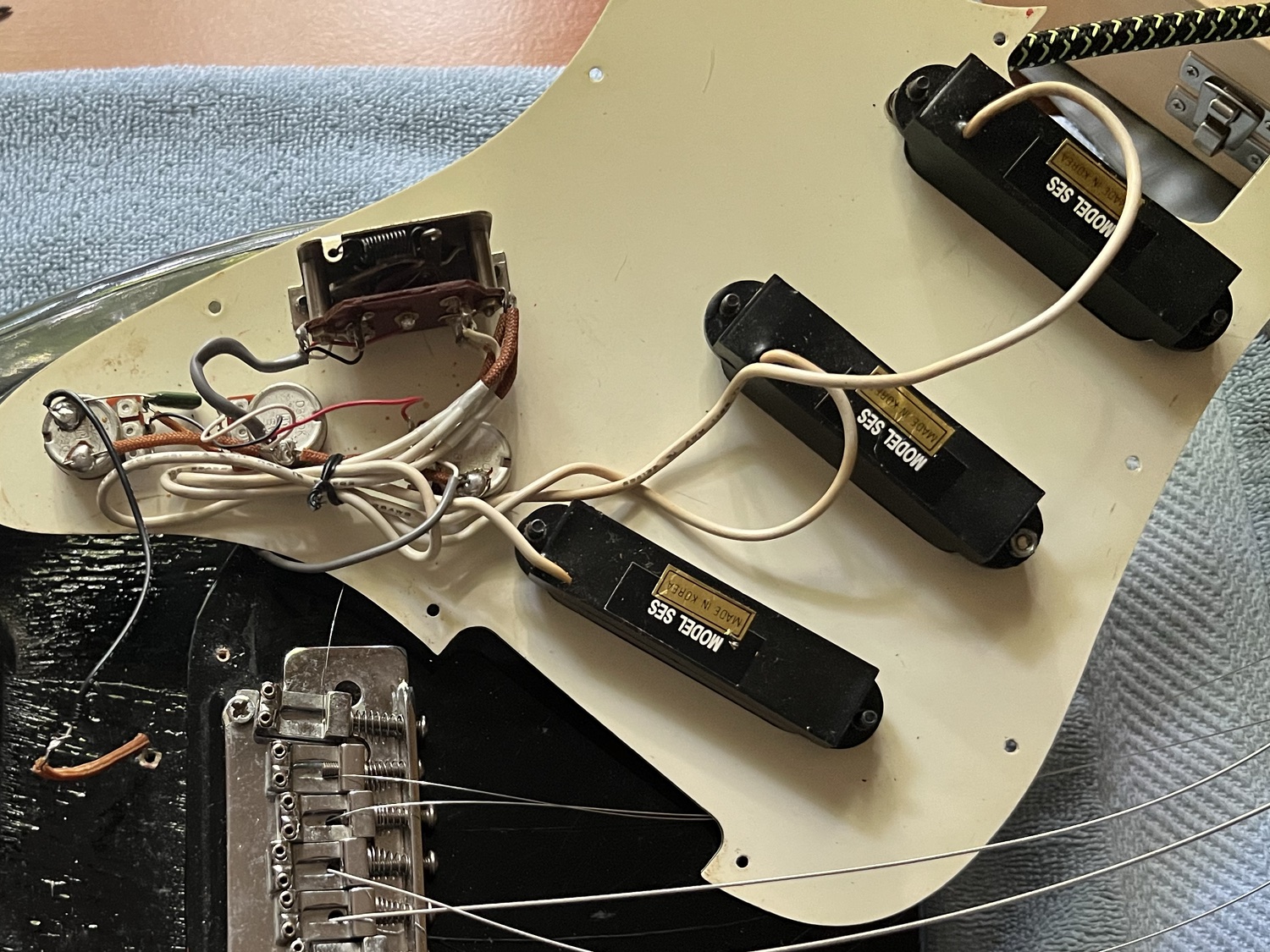
The 5-way switch needed to be replaced because the connections were intermittent. Here is the old switch, laid out quite differently from a Fender 5-way switch.
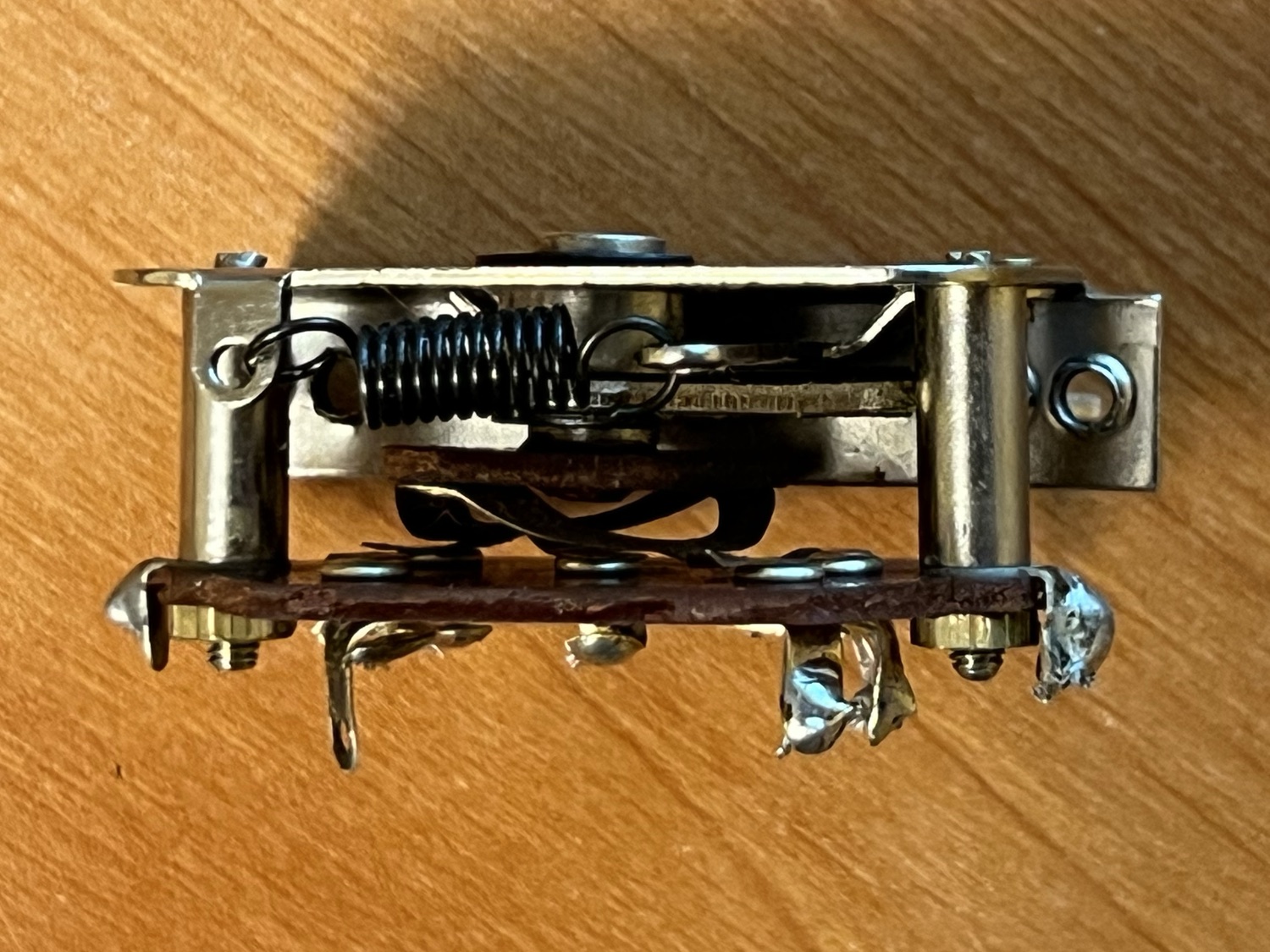
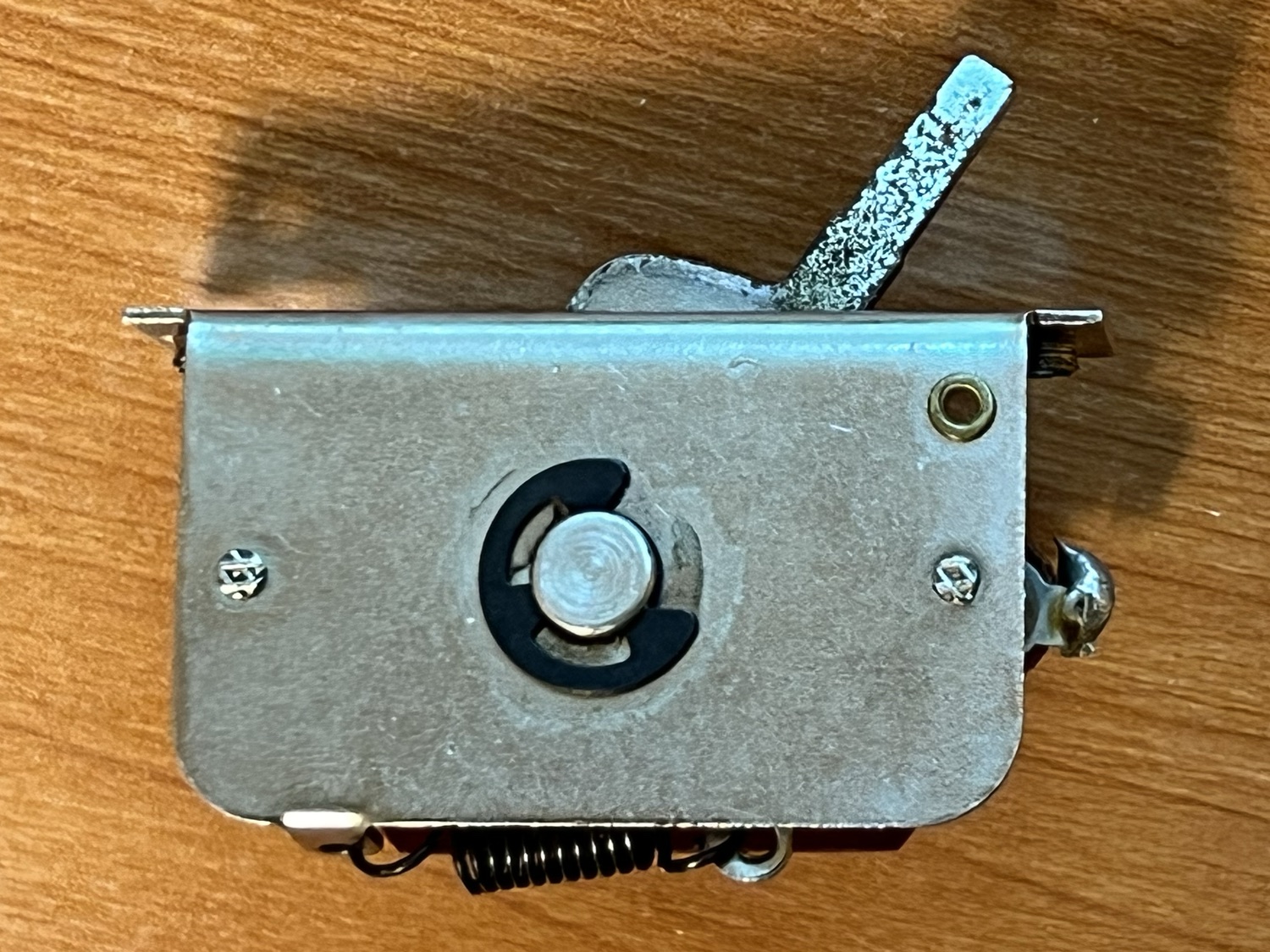
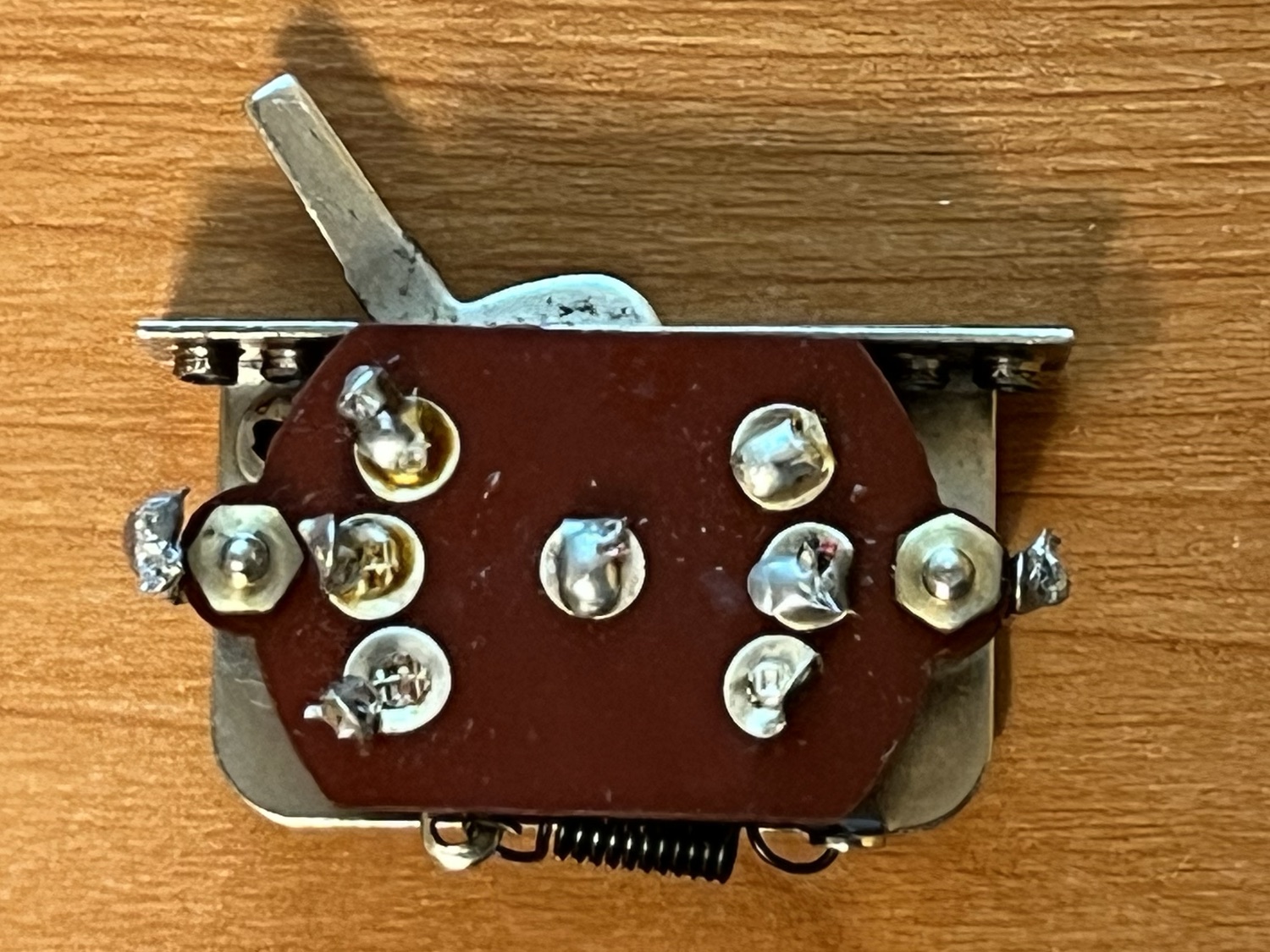
The pots also need replacing, as there is a bit of static when you turn them. They have the standard Strat arrangement and configuration with one volume and two tone knobs. The knobs are ivory with black lettering. I’ve also replaced the corroded screws on the pickguard with new screws.
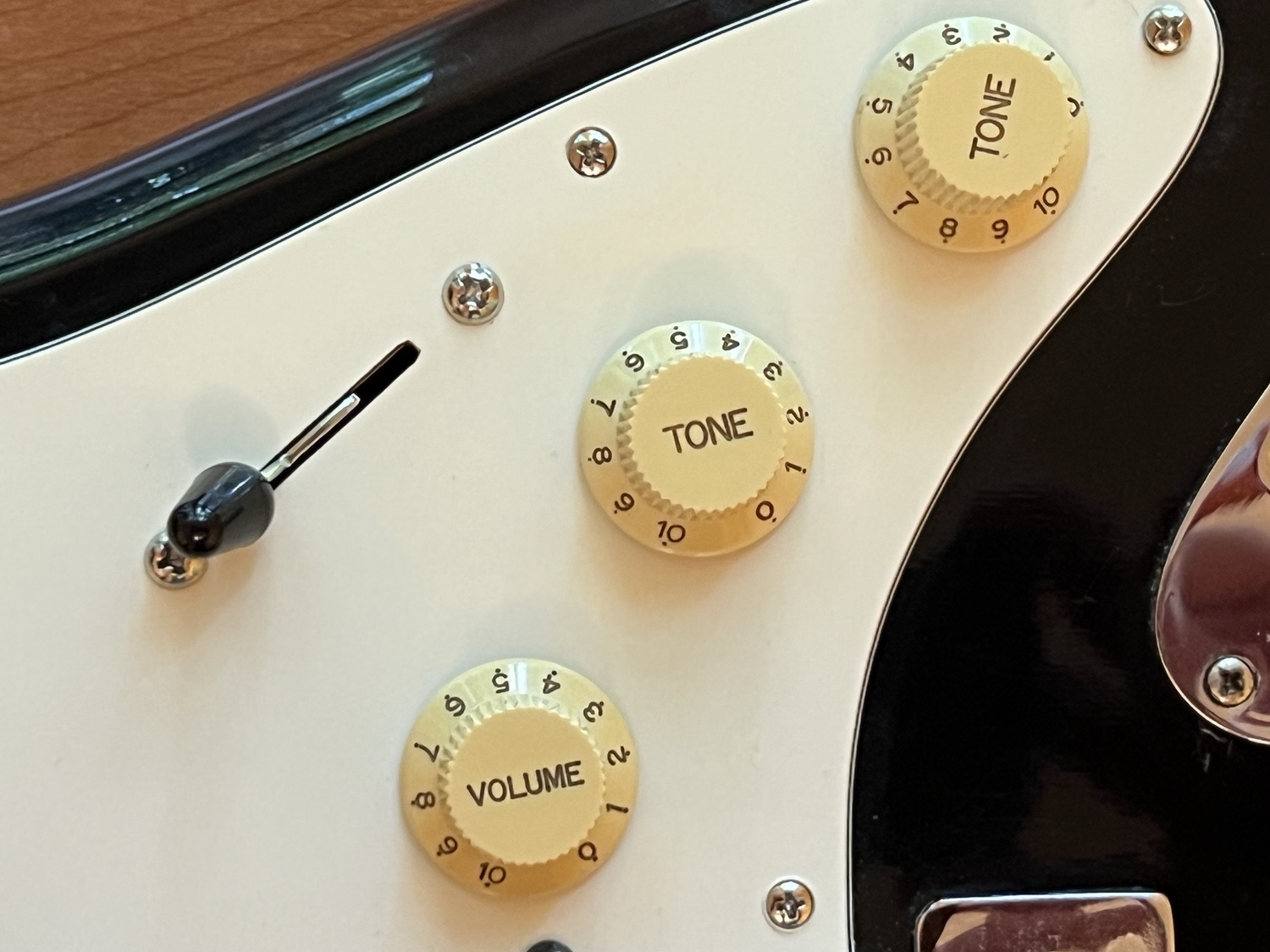
Sleuthing its origin
Lotus guitars
There’s not much information about Lotus guitars. According to Wikipedia, Lotus was the house brand of Midco International of Illinois, which sold guitars from the 1970s through the early 1990s. They used a variety of companies to manufacture their guitars, including Samick and Cort of South Korea and Mordaira (Morris) of Japan. Complicating matters, each factory issued single guitar models branded under multiple names. Samick and Cort produced most of the Lotus guitars.
My next step was to check reverb.com to see what used guitars were for sale. I found about a dozen similar guitars, and they’ve sold for between $80 and $260. They come in a variety of colors, neck woods, and headstocks, but none on Reverb match what I have.
Samick-built guitars
Websites about Samick guitars proved to be helpful. The Samick Wikia says that the Lotus-branded Samick-built Stratocaster-style guitar was the model L-680. I found several photographs of the L-680, and they are similar to mine, except in two ways. First, the L-680 consistently has a six-point tremolo system, compared with the two-point system on mine. Second, the L-680 did not have a Jackson-style headstock.
Another Samick Wikia page says that the Hondo H-7600 is the same as the Lotus L-680. Their description of the H-7600 is similar to the guitar I have, although it has the six-point tremolo system, lacks a Jackson-style headstock, and has a rosewood skunk stripe on the back of the neck.
The Samick Wikia mentions that one build option for the H-7600 was a “KKT” Licensed Floyd Rose two-point tremolo. However, the KKT was a locking tremolo system, and none of the four KKT models looked like the tremolo on mine.
The Samick Wikia headstock styles page shows something they call the inline Hockeystick Headstock (basically a Jackson-style headstock) that was used in 1988–1989, and it has the same shape as mine. They don’t report it as an option on the H-7600, but they say it was on the HK-7602. The HK-7602 had the KKT Floyd Rose tremolo, but they say it had one humbucker and two single coil pickups, and they don’t report it being made in black. So, neither the HK-7602 or the H-7600 is the guitar I have, nor is the Lotus L-680.
Cort-built guitars
A subsequent search for Cort Strats on reverb.com revealed several even closer matches, including one with a two-point tremolo that matches mine, another with the two-point tremolo, one with the Jackson headstock and the two-point tremolo, and one with the neck plate bearing the Allen (hex) screw. Other Cort guitars have the cover plate branded with the Cort logo. Although none of these have the combination of features on mine, the Jackson-style headstock and the cover plate with the hex screw make me think Cort, not Samick, manufactured mine. The lack of branding on my neck plate makes me think Cort used unbranded plates for guitars sold by other companies.
A near-exact match
Late in my search, I finally came across a Facebook post with what looks to be a near-exact match to mine. Here is a screenshot of what came up in the browser search (not Facebook; more on that below):
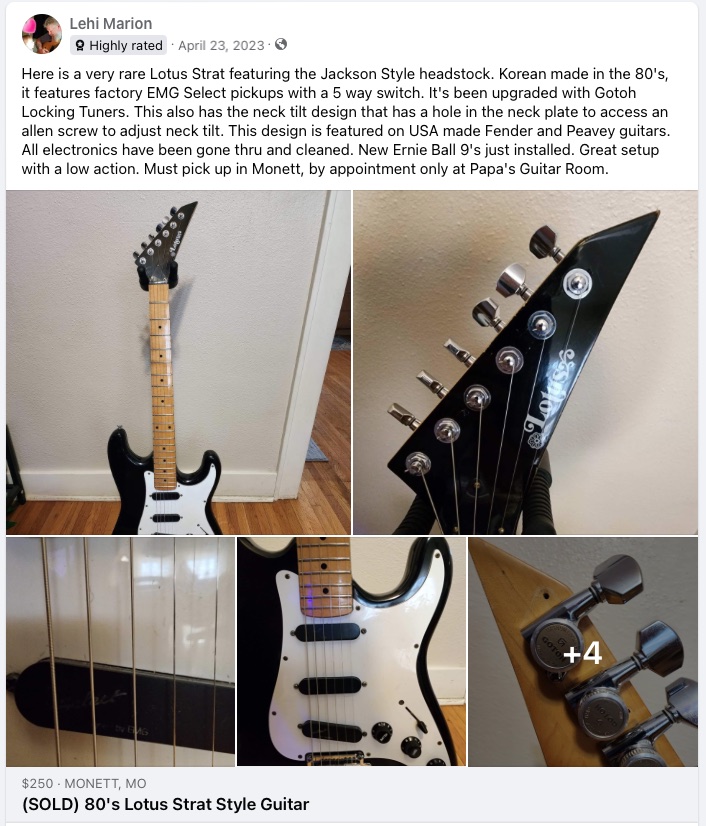
Notably, this guitar has a Jackson-style headstock, ten screws on the pickguard, and a two-point tremolo system, a combination I’ve not seen on any other guitar. The only differences I can see from my guitar are the black volume and tone knobs (ivory on mine), and the tuner-peg mods (mine has a different mod). Interestingly, the original tuner-peg drill holes are the same as mine. Also interesting is that this guitar has EMG Select pickups like mine. Either the pickups on mine aren’t mods, or it’s a coincidence that both guitars were modded the same way.
Like mine, this guitar has a two-point tremolo system and it has the neck plate with the hex screw. This and mine are the only two guitars where I’ve seen this combination of features. Although he doesn’t specify whether his guitar is a Samick or a Cort, it’s clear that there are two guitars like this in the wild.
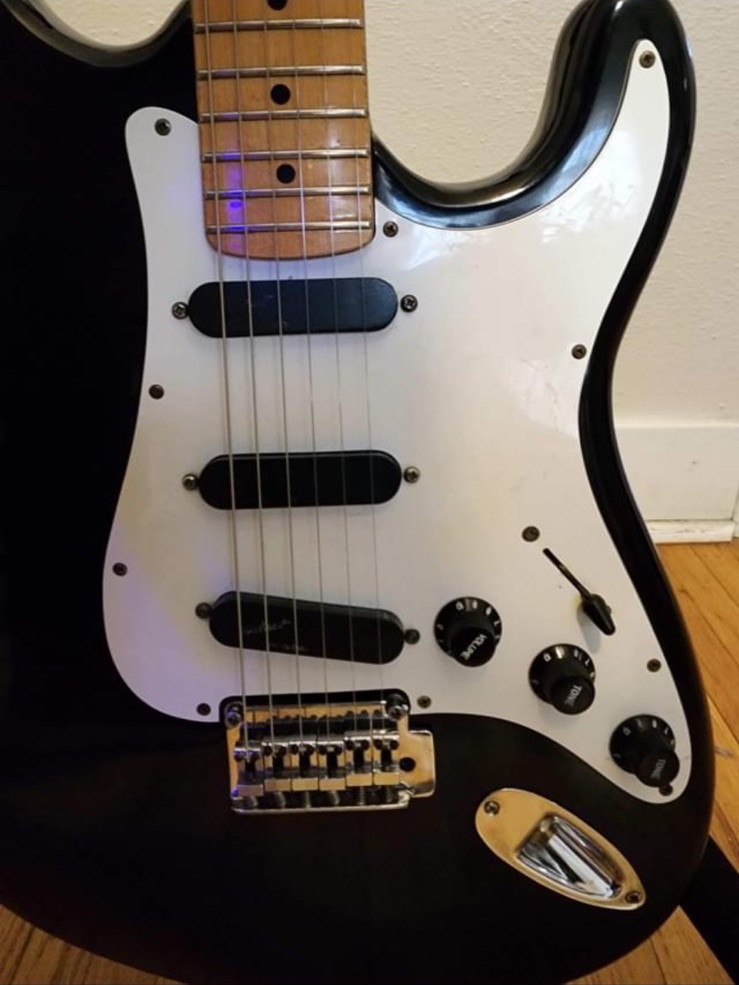
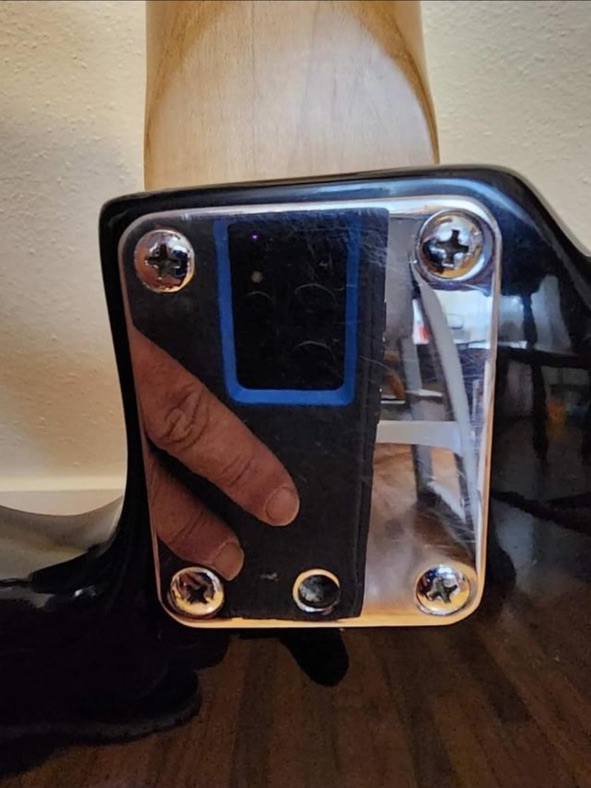
I also found a photograph of painted Lotus guitar (sky blue!) that’s nearly identical to mine. It has a two-point tremolo, the Jackson-style headstock, and a triangular truss-rod cover. The only difference is the pickups, which are white single-coil pickups with visible magnets. He does not specify whether the guitar is a Samick or a Cort, but that makes for three nearly identical guitars.
The bottom line
In the end, enough features make me think that my guitar was made by Cort, particularly the combination of the Jackson-style headstock and the 2-point tremolo. Moreover, I've seen the neck plate with a hex screw only on Cort Strats. The evidence points to it being a late 1980s guitar. I’ve not seen that many photos of Samrick guitars, so it is possible that these features are also on some Samrick guitars, but that seems unlikely. Given the available evidence, it looks like a Cort.